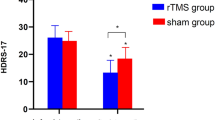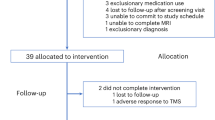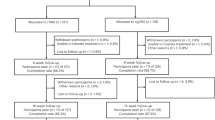Abstract
Objective
Despite high incidence of depression after stroke, few trials have investigated the therapeutic efficacy of repetitive transcranial magnetic stimulation (rTMS). Here, we aimed to evaluate clinical benefit of delivering a higher dose of rTMS compared to previous stroke trials. Secondary aims were to document adverse effects and investigate the role of functional connectivity as a potential mechanism of clinical response to rTMS treatment.
Methods
Eleven chronic stroke survivors were recruited to a double-blind, Sham-controlled, randomised trial to investigate 10 sessions of high-frequency rTMS for depression. Clinical assessments were obtained at baseline, after treatment and a 1-month follow-up. Adverse events were documented at completion of the treatment. Resting electroencephalography recordings were performed at baseline and after treatment to estimate functional connectivity.
Results
There were no differences in baseline characteristics between groups (all p ≥ 0.42). Beck Depression Inventory scores decreased for the Active rTMS group from baseline to 1-month follow-up (p = 0.04), but did not change for the Sham group at post-treatment or follow-up (p ≥ 0.17). Stronger theta frequency functional connectivity between the left frontal cortex and right parietal cortex was associated with lower baseline depression (r = − 0.71, p = 0.05). This network strength increased following Active rTMS, with change in connectivity associated with improvement in BDI scores (r = 0.98, p = 0.001). Adverse events were transient and minor and were not statistically different between groups (p ≥ 0.21).
Conclusions
Active rTMS significantly improved depression and was well tolerated. The mechanistic role of theta frequency functional connectivity appears worthy of further investigation.
The trial was registered on the Australian and New Zealand Clinical Trials Registry (ACTRN12619001303134) on September 23, 2019.




Similar content being viewed by others
Abbreviations
- BDI:
-
Beck depression inventory—II
- DLPFC:
-
Dorsolateral prefrontal cortex
- dwPLI:
-
Debiased weighted phase lag index
- FDI:
-
First dorsal interosseous
- MEP:
-
Motor evoked potential
- PHQ-9:
-
Patient health questionnaire-9
- PLS:
-
Partial least squares
- rTMS:
-
Repetitive transcranial magnetic stimulation
- RMT:
-
Repetitive transcranial magnetic stimulation
- SSEQ:
-
Stroke self-efficacy questionnaire
References
Bailey NW, Hoy KE, Rogasch NC, Thomson RH, McQueen S, Elliot D, Sullivan CM, Fulcher BD, Daskalakis ZJ, Fitzgerald PB (2018) Responders to rTMS for depression show increased fronto-midline theta and theta connectivity compared to non-responders. Brain Stimul 11:190–203
Bakker N, Shahab S, Giacobbe P, Blumberger DM, Daskalakis ZJ, Kennedy SH, Downar J (2015) rTMS of the dorsomedial prefrontal cortex for major depression: safety, tolerability, effectiveness, and outcome predictors for 10 Hz versus intermittent theta-burst stimulation. Brain Stimul 8:208–215
Beck AT, Steer RA, Brown G (1996) Beck depression inventory–II. Psychol Assess
Bladin CF, Alexandrov AV, Bellavance A, Bornstein N, Chambers B, Coté R, Lebrun L, Pirisi A, Norris JW (2000) Seizures after stroke: a prospective multicenter study. Arch Neurol 57:1617–1622
Bollen KA, Jackman RW (1990) Regression diagnostics: An expository treatment of outliers and influential cases. Modern methods of data analysis:257–291
Brunoni AR, Amadera J, Berbel B, Volz MS, Rizzerio BG, Fregni F (2011) A systematic review on reporting and assessment of adverse effects associated with transcranial direct current stimulation. Int J Neuropsychopharmacol 14:1133–1145
Button KS, Kounali D, Thomas L, Wiles NJ, Peters TJ, Welton NJ, Ades AE, Lewis G (2015) Minimal clinically important difference on the Beck Depression Inventory—II according to the patient’s perspective. Psychol Med 45:3269–3279
Chen R, Classen J, Gerloff C, Celnik P, Wassermann EM, Hallett M, Cohen LG (1997) Depression of motor cortex excitability by low-frequency transcranial magnetic stimulation. Neurology 48:1398–1403
Coupland C, Dhiman P, Morriss R, Arthur A, Barton G, Hippisley-Cox J (2011) Antidepressant use and risk of adverse outcomes in older people: population based cohort study. BMJ 343
Dozois DJ, Dobson KS, Ahnberg JL (1998) A psychometric evaluation of the beck depression inventory–II. Psychol Assess 10:83
Fitzgerald PB, Daskalakis ZJ (2011) The effects of repetitive transcranial magnetic stimulation in the treatment of depression. Expert Rev Med Devices 8:85–95
Fox MD, Liu H, Pascual-Leone A (2013) Identification of reproducible individualized targets for treatment of depression with TMS based on intrinsic connectivity. Neuroimage 66:151–160
George MS, Wassermann EM, Kimbrell TA, Little JT, Williams WE, Danielson AL, Greenberg BD, Hallett M, Post RM (1997) Mood improvement following daily left prefrontal repetitive transcranial magnetic stimulation in patients with depression: a placebo-controlled crossover trial. AJ Psychiatry 154:1752–1756
Gu SY, Chang MC (2017) The effects of 10-Hz repetitive transcranial magnetic stimulation on depression in chronic stroke patients. Brain Stimul 10:270–274
Hackett ML, Pickles K (2014) Part I: frequency of depression after stroke: an updated systematic review and meta-analysis of observational studies. Int J Stroke 9:1017–1025
Hackett ML, Yapa C, Parag V, Anderson CS (2005) Frequency of depression after stroke: a systematic review of observational studies. Stroke 36:1330–1340
Hordacre B, Comacchio K, Moseley GL (2020) The unusual case of dental pain with sham repetitive transcranial magnetic stimulation: A benign idiosyncrasy or diagnostic opportunity? Brain Stimul 13:422–423
Hordacre B, Goldsworthy MR, Welsby E, Graetz L, Ballinger S, Hillier S (2020) Resting state functional connectivity is associated with motor pathway integrity and upper-limb behavior in chronic stroke. Neurorehabil Neural Repair 34:547–557
Hordacre B, Moezzi B, Goldsworthy MR, Rogasch NC, Graetz LJ, Ridding MC (2017) Resting state functional connectivity measures correlate with the response to anodal transcranial direct current stimulation. Eur J Neurosci 45:837–845
Hordacre B, Moezzi B, Ridding MC (2018) Neuroplasticity and network connectivity of the motor cortex following stroke: a transcranial direct current stimulation study. Hum Brain Mapp 39:3326–3339
Jones F, Partridge C, Reid F (2008) The stroke self-efficacy questionnaire: measuring individual confidence in functional performance after stroke. J Clin Nurs 17:244–252
Jones F, Riazi A (2011) Self-efficacy and self-management after stroke: a systematic review. Disabil Rehabil 33:797–810
Jorge RE, Robinson RG, Tateno A, Narushima K, Acion L, Moser D, Arndt S, Chemerinski E (2004) Repetitive transcranial magnetic stimulation as treatment of poststroke depression: a preliminary study. Biol Psychiatry 55:398–405
Klein E, Kreinin I, Chistyakov A, Koren D, Mecz L, Marmur S, Ben-Shachar D, Feinsod M (1999) Therapeutic efficacy of right prefrontal slow repetitive transcranial magnetic stimulation in major depression: a double-blind controlled study. Arch Gen Psychiatry 56:315–320
Kroenke K, Spitzer RL (2002) The PHQ-9: a new depression diagnostic and severity measure. Psychiatric annals 32:509–515
Kroenke K, Spitzer RL, Williams JB (2001) The PHQ-9: validity of a brief depression severity measure. J Gen Intern Med 16:606–613
Liston C, Chen AC, Zebley BD, Drysdale AT, Gordon R, Leuchter B, Voss HU, Casey BJ, Etkin A, Dubin MJ (2014) Default mode network mechanisms of transcranial magnetic stimulation in depression. Biol Psychiatry 76:517–526
Löwe B, Unützer J, Callahan CM, Perkins AJ, Kroenke K (2004) Monitoring depression treatment outcomes with the patient health questionnaire-9. Med Care:1194–1201
Machii K, Cohen D, Ramos-Estebanez C, Pascual-Leone A (2006) Safety of rTMS to non-motor cortical areas in healthy participants and patients. Clin Neurophysiol 117:455–471
Menzies L, Achard S, Chamberlain SR, Fineberg N, Chen CH, del Campo N, Sahakian BJ, Robbins TW, Bullmore E (2007) Neurocognitive endophenotypes of obsessive-compulsive disorder. Brain 130:3223–3236
Muellbacher W, Ziemann U, Boroojerdi B, Hallett M (2000) Effects of low-frequency transcranial magnetic stimulation on motor excitability and basic motor behavior. Clin Neurophysiol 111:1002–1007
O’Reardon JP, Solvason HB, Janicak PG, Sampson S, Isenberg KE, Nahas Z, McDonald WM, Avery D, Fitzgerald PB, Loo C, Demitrack MA, George MS, Sackeim HA (2007) Efficacy and safety of transcranial magnetic stimulation in the acute treatment of major depression: a multisite randomized controlled trial. Biol Psychiatry 62:1208–1216
Paolucci S (2008) Epidemiology and treatment of post-stroke depression. Neuropsychiatr Dis Treat 4:145–154
Pascual-Leone A, Rubio B, Pallardó F, Catalá MD (1996) Rapid-rate transcranial magnetic stimulation of left dorsolateral prefrontal cortex in drug-resistant depression. The Lancet 348:233–237
Pascual-Leone A, Valls-Solé J, Wassermann EM, Hallett M (1994) Responses to rapid-rate transcranial magnetic stimulation of the human motor cortex. Brain 117:847–858
Quartarone A, Bagnato S, Rizzo V, Morgante F, Sant’Angelo A, Battaglia F, Messina C, Siebner HR, Girlanda P (2005) Distinct changes in cortical and spinal excitability following high-frequency repetitive TMS to the human motor cortex. Exp Brain Res 161:114-124
Robinson RG, Spalletta G (2010) Poststroke depression: a review. Can J Psychiatry 55:341–349
Roger VL, Go AS, Lloyd-Jones DM, Benjamin EJ, Berry JD, Borden WB, Bravata DM, Dai S, Ford ES, Fox CS (2012) Heart disease and stroke statistics—2012 update a report from the American heart association. Circulation 125:e2–e220
Rossi S, Hallett M, Rossini PM, Pascual-Leone A (2011) Screening questionnaire before TMS: an update. Clin Neurophysiol 122:1686
Sauseng P, Klimesch W (2008) What does phase information of oscillatory brain activity tell us about cognitive processes? Neurosci Biobehav Rev 32:1001–1013
Sawada N, Uchida H, Suzuki T, Watanabe K, Kikuchi T, Handa T, Kashima H (2009) Persistence and compliance to antidepressant treatment in patients with depression: a chart review. BMC Psychiatry 9:38
Schiemanck SK, Post MW, Witkamp TD, Kappelle LJ, Prevo AJ (2005) Relationship between ischemic lesion volume and functional status in the 2nd week after middle cerebral artery stroke. Neurorehabil Neural Repair 19:133–138
Turner-Stokes L, Hassan N (2002) Depression after stroke: a review of the evidence base to inform the development of an integrated care pathway. Part 2: treatment alternatives. Clin Rehabil 16:248–260
Vinck M, Oostenveld R, Van Wingerden M, Battaglia F, Pennartz CMA (2011) An improved index of phase-synchronization for electrophysiological data in the presence of volume-conduction, noise and sample-size bias. Neuroimage 55:1548–1565
Volz M, Möbus J, Letsch C, Werheid K (2016) The influence of early depressive symptoms, social support and decreasing self-efficacy on depression 6 months post-stroke. J Affect Disord 206:252–255
Ward NS, Brown MM, Thompson AJ, Frackowiak RS (2003a) Neural correlates of motor recovery after stroke: a longitudinal fMRI study. Brain 126:2476–2496
Ward NS, Brown MM, Thompson AJ, Frackowiak RSJ (2003b) Neural correlates of outcome after stroke: A cross-sectional fMRI study. Brain 126:1430–1448
Whyte EM, Mulsant BH (2002) Post stroke depression: epidemiology, pathophysiology, and biological treatment. Biol Psychiatry 52:253–264
Acknowledgements
The authors would like to acknowledge Dr Tobias Loetscher for assistance during study design.
Funding
This research was funded by a Research Themes Investment Scheme—University of South Australia grant. BH was supported by National Health and Medical Research Council (NHMRC) fellowship (1125054).
Author information
Authors and Affiliations
Corresponding author
Ethics declarations
Conflicts of interest
None of the authors have potential conflicts of interest to be disclosed.
Ethical standard
This study was approved by the University of South Australia Human Research Ethics Committee (ID number 200697). The study conformed to the standards defined in the latest revision of the Declaration of Helsinki. All patients and controls signed a written informed consent.
Electronic supplementary material
Below is the link to the electronic supplementary material.
Rights and permissions
About this article
Cite this article
Hordacre, B., Comacchio, K., Williams, L. et al. Repetitive transcranial magnetic stimulation for post-stroke depression: a randomised trial with neurophysiological insight. J Neurol 268, 1474–1484 (2021). https://doi.org/10.1007/s00415-020-10315-6
Received:
Revised:
Accepted:
Published:
Issue Date:
DOI: https://doi.org/10.1007/s00415-020-10315-6




